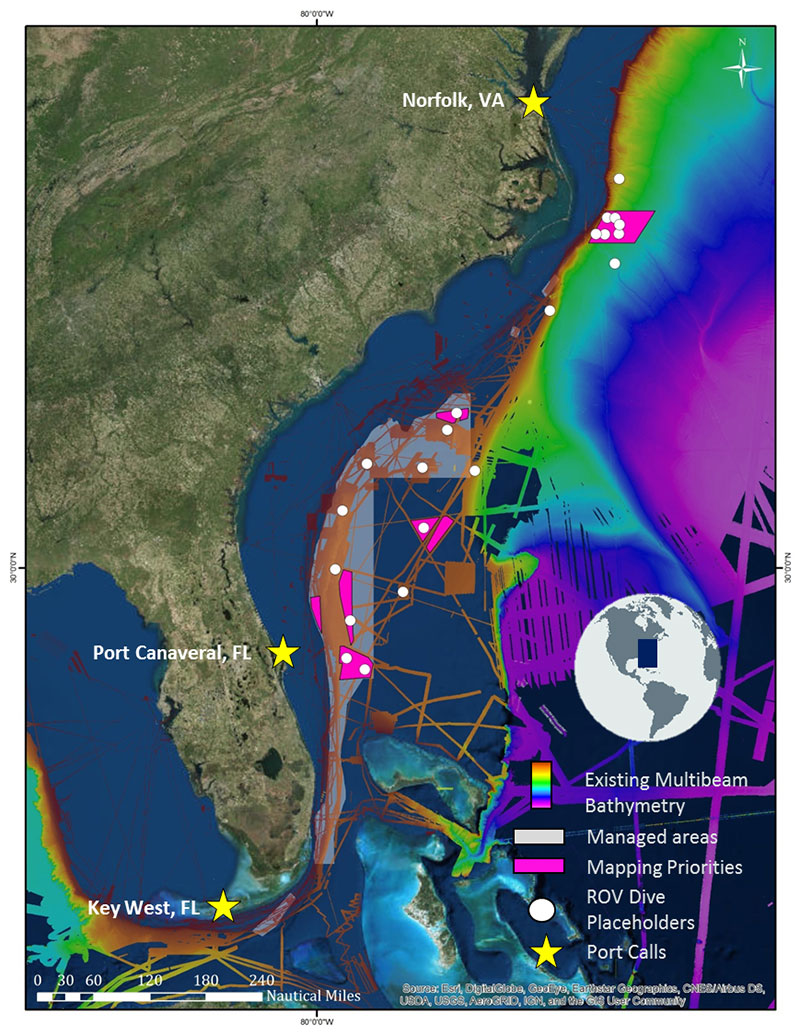
by Kasey Cantwell and Michael White, NOAA Office of Ocean Exploration and Research

Map of the Windows to the Deep 2019 expedition, during which we will focus operations offshore the southeast United States. Shown here, the pink polygons represent mapping priorities and white dots represent planned ROV dive locations. Image courtesy of the NOAA Office of Ocean Exploration and Research. Download image (jpg, 7.1 MB).
From May 30 through July 12, 2019, NOAA and partners will conduct a two-part, telepresence-enabled ocean exploration expedition on NOAA Ship Okeanos Explorer to collect critical baseline information about unknown and poorly understood deepwater areas of the Southeastern United States. Though the East Coast is home to millions of Americans and is experiencing some of the highest population growth rates in the United States, the southeast U.S. continental margin has some of the largest gaps in high-resolution ocean mapping data on the East Coast and limited previous observations via submersibles. In fact, the deepwater areas offshore Florida, Georgia, South Carolina, and North Carolina are some of the least explored areas along the U.S. East Coast.
EX-19-03 Leg 1 (May 30 - June 14): Mapping operations will focus on high-priority areas identified by the South Atlantic Fishery Management Council, NOAA, Bureau of Ocean Energy Management (BOEM), and the science community.
EX-19-03 Leg 2 (June 20 - July 12): Operations will consist of daytime remotely operated vehicle (ROV) dives and overnight mapping operations. ROV dive sites are expected to include deep-sea coral and sponge habitats, submarine canyons, potential methane seeps, maritime heritage sites, and midwater exploration.
Like previous expeditions, NOAA will work with the scientific and resource management communities to characterize high-priority exploration targets. This two-part expedition will use the ship’s deepwater mapping systems (Kongsberg EM302 multibeam sonar, Simrad EK60 and EK80 split-beam fisheries sonars, Knudsen 3260 chirp sub-bottom profiler sonar, and Teledyne Acoustic Doppler Current Profiler); NOAA’s two-body deepwater ROV; and a high-bandwidth satellite connection for real-time ship-to-shore communications. ROV dives will include high-resolution visual surveys of water column and seafloor habitats as well as biologic and geologic sampling. This expedition will help establish a baseline of information in several deepwater regions to catalyze further exploration, research, and management activities.
By leading national efforts to explore our ocean and making ocean exploration more accessible, the NOAA Office of Ocean Exploration and Research (OER) is filling gaps in the basic understanding of U.S. deep waters and seafloor, providing critical deep-ocean data, information, and awareness needed to sustain and accelerate the economy, health, and security of our nation.
On May 30, we will kick off the first leg of our 2019 Windows to the Deep expedition. As data starts to come in from never-before-mapped areas, our team on shore will start evaluating it to see if we’d like to conduct ROV dives in any of the areas. We have several placeholders for ROV dives that have been specifically set aside for just this purpose and will be finalized only a few days before the expedition, once the data from Leg 1 are in.
Several of the areas that will be mapped for the first time during Leg 1 have lines of transit data over them that tantalizingly hint at exciting secrets just waiting to be revealed. During Leg 2, we’ll get a chance to take a look at features our team finds interesting in hopes of finding shipwrecks, deep-sea corals, methane seeps, and more. We can’t wait to see what we discover and hope that you’ll join us on this journey!